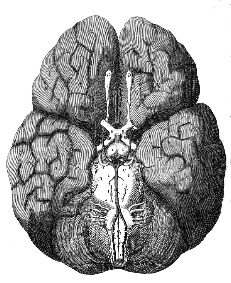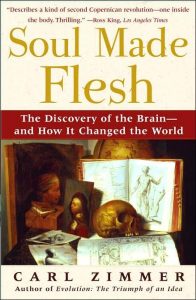Soul Made Flesh:
The Discovery of the Brain and How It Changed the World
Watch a lecture about Soul Made Flesh delivered at the Stanford University School of Medicine on C-SPAN’s video archive.
A New York Times Book Review Notable Book of the Year
Soul Made Flesh tells the story of a dramatic turning point in history–the discovery of the role and importance of the human brain. The secrets of the brain were uncovered in seventeenth century England, against a deadly backdrop of civil war, regicide, and plague. At the beginning of this turbulent century, no one know how the brain worked; they didn’t even know what an intact brain looked like. By the century’s close, the science of the brain had been established, helping to overturn misconceptions about the body and to unseat philosophies about the mind and the universe that had ruled Western thought for centuries. Presiding over the rise of this new science was the founder of modern neurology, Thomas Willis, a fascinating yet forgotten figure who stood at the center of an extraordinary group of natural philosophers known as the Oxford Circle. Soul Made Flesh chronicles their groundbreaking revelations and gory experiments that first enshrined the brain as the chemical engine of reason, emotion, and madness–as the very seat of the human soul.

What People Are Saying
Steven Pinker, Harvard University,
author of How the Mind Works and The Blank Slate
“Today the idea that every aspect of human experience consists of activity in the brain is second nature to some people and an ‘astonishing hypothesis’ –or even sacrilege–to others. But few are aware of the ancestry of this idea. Soul Made Flesh tells the fascinating story of how people first became aware of one of the most radical thoughts the human mind has ever had to think. The writing is vivid and literate, the story compelling, and the modern implications drawn out with skill and verve.”
Neal Stephenson, author of Quicksilver and Cryptonomicon
“Carl Zimmer clarifies and illuminates the story of a fascinating thinker who too often gets lost among the crowd of colorful geniuses who made up the early Royal Society. By focusing on a single player in the vast spectacle that was the Scientific Revolution, and telling his story so well, Zimmer gives us insights into the age when Alchemy, and even older systems of thought, gave way to modern science. But this is not only a history book, for readers with an interest in consciousness and the brain will find much here that applies to research going on today.”
Oliver Sacks, author of Uncle Tungsten and Awakenings
“Thomas Willis was the first man to come to grips with the human brain, to see how different parts of it had different functions, and how the human soul could be embodied in it. In Soul Made Flesh, Carl Zimmer gives a remarkable, beautiful account of England’s ‘genius century,’ and of the intertwined lives of Willis and his contemporaries, Harvey, Boyle, and Hooke. Zimmer brings Willis and his intellectual journey to life–his prose, as always, is clear, vivid, and arresting–and reminds us how startling and revolutionary his discoveries were.”
Ross King, Los Angeles Times
“Fascinating…thrilling… Zimmer has produced a top-notch work of popular science.” Full review
Sunday Telegraph (London)
“Soul Made Flesh is a tour de force, eloquently and excitingly written, powerfully re-creating the atmosphere and personalities of the time, and making the science agreeably intelligible to the non-scientist.” Full review
New York Times Book Review
“Carl Zimmer’s illuminating book charts a fascinating chapter in the soul’s journey.” Full review
Lisa Jardine Sunday Times (London)
“This is a much-needed book on an extraordinary 17th-century figure.” Full review
Excerpt
Introduction: A Bowl of Curds
To imagine a time and place—say, the city of Oxford on a summer day in 1662—you have to engage not only the mind’s eye and ear but also the mind’s nose. The warm odor of malt and corn flour rises from the boats landing at the wharves along the Thames. The stink of cured fish hanging in fishmongers’ stalls mixes with the soft smell of bread in the bakeries. The smell of manure is everywhere, in the open sewers, on the town common where cows graze, in the streets where horses haul wagons and coaches. Sometimes a coach rolls through the narrow gate of one of Oxford’s colleges, to be swallowed up behind a high, windowless stone wall. The chimneys of the college kitchens relay smoke signals to the surrounding neighborhoods, carrying the smell of roasting capon and mutton or perhaps a goose stolen from a nearby village by students.
On a summer day the perfume of the surrounding fens and meadows drifts into the city and mixes with the exotic scents of the physik garden on the High Street, a home to exotic species such as leopard’s bane, mimosa trees, Virginian spiderwort, and scorpion grass. Botanists gather their leaves and seeds and roots and carry them to an apothecary’s shop to be ground down, cooked, distilled, and mixed with sharp-odored hartshorn or spirits of wine.
Every building in Oxford has an internal signature of smells: the incense burning in the churches once again, now that the Puritans have been routed and the monarchy restored; the roasted beans in the new coffeehouse on High Street; the foul reek of the prisons, where thieves, Quakers, and various enemies of King Charles II languish together. But the strangest smells in all of Oxford can be found off the main thoroughfares, on Merton Street. Across the street from the gates of Merton College is a medieval two-story house known as Beam Hall. Its odors are almost unbearable: a reeking blend of turpentine and the warm, decaying flesh of dissected dogs and sheep, along with an aroma that none but a handful of people in Oxford—in the world, even—would recognize as that of a nobleman’s decapitated and freshly cracked open head.
The room where his body is being dissected is something between a laboratory and a butcher’s shop. Knives, saws, and gimlets hang on the walls, along with pliers and razors, brass and silver probes, pincers, bugles for inflating membranous sacs, curved needles, augurs, mallets, wimbles, and bodkins. Syringes and empty quills sit on a table, along with bottles of tincture of saffron and a simple microscope, illuminated by an oil lamp and a globe of brine. Hearts rest at the bottom of jars, pickled. On a long table lies the corpse, surrounded by a crowd of natural philosophers. Depending on the day, the audience may include a mathematician who is laying the groundwork for calculus or a chemist who is in the process of turning alchemy into a modern science. Astronomers, doctors, and ministers come to watch. They all stare intensely, because they know they are part of an unprecedented experience. They are anatomizing the soul.
An inner circle of men stands closest to the body. Christopher Wren, thirty years old and not yet England’s great architect, studies the exposed flanges and curves of the skull. He can sketch bowels and hearts as beautifully as he will later sketch a cathedral dome. Richard Lower, who in a few years will perform the first successful blood transfusion in history, severs the nobleman’s carotid arteries and slices the gristly cartilage between his cervical vertebrae. The finest dissector in all Europe, he serves as assistant to another man in the inner circle, the owner of Beam Hall, the man who has assembled this herd of natural philosophers within its walls—a short, stammering physician with hair that one neighbor describes in his diary as being “like a dark red pigge.” His name is Thomas Willis.
Willis has brought these men together this day in 1662 in order to come to a new understanding of the brain and nerves. He and Lower strip the skin and then cut away the inner mask of muscle. They saw off the bones of the skull, prying away each one with a penknife or a pair of scissors. They snip the nerves that tether the brain to the eye and nose. All that is left is the brain encased in its membranes. Next Willis and Lower turn the brain upside down and gently peel away the membranes so as not to damage the delicate nerves and blood vessels at its base. Furrowed and lobed, the brain is liberated, and Willis holds it aloft for his audience to see.
Today, when we look at a brain, we see an intricate network of billions of neurons in constant, crackling communication, a chemical labyrinth that senses the world outside and within, produces love and sorrow, keeps our hearts beating and lungs breathing, composes our thoughts, and constructs our consciousness. To most people in 1662, however, this would all have sounded quite absurd. When the contemporary English philosopher Henry More wrote about the brain, he declared that “this laxe pith or marrow in man’s head shows no more capacity for thought than a cake of suet or a bowl of curds.” The brain, More wrote, was a watery, structureless substance which could not contain the complex workings of the soul. The idea that the frail flesh in our heads was capable of the soul’s work was more than just absurd. It bordered on atheism. If reason, devotion, and love were the work of mortal flesh instead of immaterial spirit, then what would become of the soul after death? What need was there for a soul at all? Henry More put the matter simply: “No spirit, no God.”
Exactly what spirits and soul consisted of and where they could be found were questions that had been asked and re-asked for well over two thousand years. At the beginning of the seventeenth century, most Europeans would have agreed that the soul was the immortal, immaterial essence of a person, which would be saved or damned by God. But the same word could also refer to an intelligence at work throughout the entire body—making it grow to its destined shape, making it warm and alive, reproducing its form in children. Spirits were the instruments used by the soul and body to reach their goals. For many philosophers, alchemists, apothecaries, and mystics, the cosmos also had a soul, which channeled spirits through planets and stars to enact its will—spirits that could be harnessed by magic or alchemy. With each breath, the world’s spirits entered the human body and infused it with life and intelligence, uniting the soul of the microcosm with the soul of the macrocosm.
As widely held as all these beliefs were in 1600, they were being steadily undermined. By the end of the seventeenth century, they would all be either obliterated or fatally wounded, and Thomas Willis and his friends were playing a crucial role in the transformation. Their grisly work in Beam Hall was the first modern investigation of the nervous system. Whenever Willis held a brain in his hands and described it to his audience, he did not limit himself to the branchings of nerves and other anatomical details. He showed how the brain’s intricate structures could form memories, hatch imaginations, experience dreams. He reconceived thoughts and passions as a chemical storm of atoms. Willis called his brain project a “doctrine of the nerves” and coined a new Latin word for it: neurologie.
Although Willis and his friends were establishing the modern science of the brain, they do not fit the modern definition of a scientist. Some were alchemists who searched out the philosopher’s stone so as to be able to communicate with angels. Some were physicians who recommended carved-up puppies for clearing the skin. All of them were seeking signs of God’s work in a universe that had become terrifying and alien. They were scarred by civil war and hoped that a new conception of the brain would bring order and tranquility to the world. Their claims were often accepted not so much because they were true (which, fairly often, they were not), but because the world itself had developed an appetite for them.
These men of Oxford ushered in a new age, one in which we still live—call it the Neurocentric Age—in which the brain is central not only to the body but to our conception of ourselves. The seventeenth century saw many scientific revolutions, but in some ways the revolution of the brain is its most shattering triumph—and its most intimate. It created a new way of thinking about thinking and a new way of conceiving the soul. Today, some three hundred forty years later, the Neurocentric Age is more deeply entrenched than ever. At the beginning of the twenty-first century, thousands of neuroscientists follow Willis’s trail. They continue to dismantle the brain, but they don’t have to pull it from a corpse to do so. Instead, they can scan the positronic glow of neurons recalling the faces of friends, searching for a word, generating anger or bliss, or reading the minds of others. These scientists have started to isolate the molecules that these neurons trade and are manipulating them with drugs.
To some extent, we have become comfortable with this new brain. Few will deny that the workings of our minds are the product of billions of neurons organized into clusters and networks, trading trillions of signals with one another every second. We demonstrate our comfort by buying billions of dollars of drugs in the hope of lifting our mood, calming our jitters, or otherwise modifying who we are, simply by boosting or squelching the right neurochemical signals.
This comfort may have come too easily. The big business of brain drugs belies science’s enormous ignorance about the organ. The maps that neuroscientists make today are like the early charts of the New World with grotesque coastlines and blank interiors. And what little we do know about how the brain works raises disturbing questions about the nature of our selves. In many ways, we are still standing in the circle at Beam Hall, with the odor of discovery in our noses, looking at the brain and wondering what this strange new thing is that Thomas Willis has found.
Copyright © 2004 by Carl Zimmer

